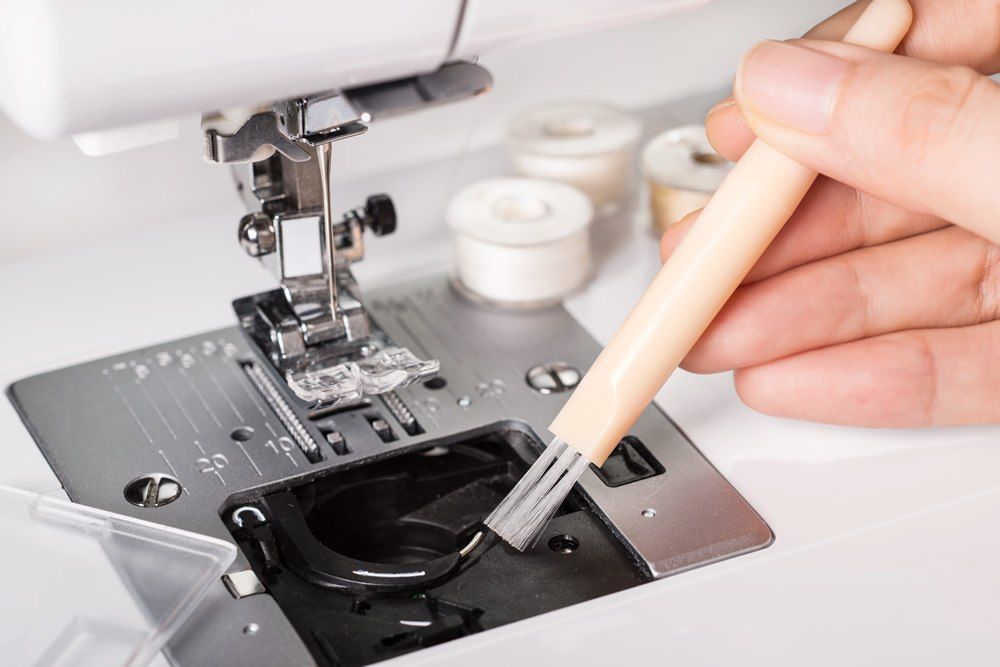Embroidery Machine Maintenance Guide: How To Keep Your Machine in Prime Condition
Machine embroidery feels like magic, but there is a seriously complicated machine behind that wonder. All machines needs to be maintained from time to time and not doing so can cause a lot of embroidery machine issues you’ll need to troubleshoot.
While you can always go to a shop and get a professional tune up and cleaning, this service will likely run you $100 per visit, and there’s no reason you can’t do it yourself with a little effort.
Why Regular Maintenance Matters
Performing regular maintenance on your embroidery machine can help you keep ahead of common issues. Keeping a cleaned and well-oiled machine can help prevent thread breaks, ensure optimal sew outs, and reduce wear and tear on the vital mechanisms that allow your embroidery machine to do what it does!
Regular maintenance even helps catch and address minor issues before they escalate into major, potentially costly problems. You wouldn’t allow your car to run without ever having an oil change would you? So, make sure to treat your embroidery machine with the same love and care if you want it to last.
Tools and Supplies List For Embroidery Machine Maintenance
Performing routine maintenance on your at-home embroidery machine is not difficult, but you will need a few tools and supplies to get the job done. Here’s a recommended list of supplies to keep your machine in tip-top shape.
Cleaning Tools
- Lint Brushes or Compressed Air: For removing lint and debris from the bobbin area, tension discs, and other critical components.
- Small Vacuum Cleaner: Ideal for sucking up any loose threads or lint without causing damage.
- Soft Brushes: Used to gently clean delicate parts without scratching or damaging surfaces.
Lubrication Supplies
- Sewing Machine Oil: Specifically designed for lubricating moving parts. Follow the manufacturer’s recommendations for the type of oil to use.
- Tweezers or Oil Applicator: For precise application of oil to small, hard-to-reach areas.
Calibration Tools
- Small Screwdriver Set: For making minor adjustments to tension and other settings.
Adjustment Tools
- Needle Nose Pliers: Useful for tasks like adjusting tension discs and handling small components.
- Bobbin Tension Gauge: Ensures proper tension in the bobbin thread.
General Maintenance Supplies
- Lint-Free Cloths: For wiping down surfaces and components without leaving behind fibers.
- Brushes with Soft Bristles: Gentle brushes for cleaning sensitive areas.
- Machine-Specific Screwdriver: Ensure you have the correct screwdriver for any parts that may need disassembly.
Protective Items
- Latex or Nitrile Gloves: Protect your hands from any residual oil or cleaning agents.
- Safety Glasses: Especially useful when using compressed air to prevent any debris from getting into your eyes.
Reference Materials
- User Manual: Keep your machine’s user manual handy for guidance on specific maintenance procedures.
- Manufacturer’s Recommendations: Check for any specific recommendations from the manufacturer regarding cleaning agents, lubricants, or maintenance schedules.
So, How often should you clean and maintain your embroidery machine?
There are a lot of moving parts to an embroidery machine, and if you want yours to last as long as possible you should perform your routine maintenance on a schedule. Some tasks, like cleaning the bobbin area should be done every day, but more in-depth thorough cleaning can be done monthly. Check the below schedule for reference.
| Maintenance Task | Daily | Weekly | Monthly |
|---|---|---|---|
| Clean Bobbin Area | ✓ Use lint brush or compressed air | ✓ Inspect for lint and clean if needed | ✓ Thorough cleaning, check for any wear or damage |
| Inspect and Change Needles | ✓ Regularly check for damage | ✓ Change needles if showing wear | ✓ Change needles after 8-10 hours of stitching |
| Check and Adjust Tension | ✓ Test tension with a sample stitch | ✓ Adjust tension as needed | ✓ Perform a comprehensive tension check |
| Clean the Thread Path | ✓ Wipe down thread path with a lint-free cloth | ✓ Ensure smooth thread flow | ✓ Thoroughly clean thread path, check for obstructions |
| Verify Bobbin Thread Quality | ✓ Check for even winding and any irregularities | ✓ Rewind bobbin if necessary | ✓ Ensure even winding, lubricate bobbin case if required |
| Run a Test Stitch | ✓ Stitch a sample on scrap fabric | ✓ Check for tension issues, breaks, or skips | ✓ Comprehensive test stitch to identify any issues |
| Wipe Down Machine Surfaces | ✓ Wipe exterior surfaces with a lint-free cloth | ✓ Keep surfaces free from oil and debris | ✓ Thoroughly clean machine surfaces, check for buildup |
| Empty the Bobbin | ✓ If not in the middle of a project | ✓ Consider changing bobbin thread | ✓ Change bobbin thread, inspect bobbin case |
| Secure Loose Fasteners | ✓ Check for any loose screws or fasteners | ✓ Tighten as needed to prevent vibrations | ✓ Ensure all fasteners are secure |
| Record Maintenance in a Log | ✓ Keep a log of daily tasks | ✓ Record weekly maintenance and adjustments | ✓ Document comprehensive monthly maintenance |
Daily/Weekly Embroidery Machine Maintenance Routine
Daily maintenance is quick and easy and should be done every time you’re finished using your embroidery machine. These simple tasks help to ensure optimal performance the next time you use the machine.
Clean the Bobbin Area:
- Use a lint brush or compressed air to remove any lint or thread buildup in the bobbin area.
- Check for and remove any loose threads that might be caught in the bobbin case.
Inspect and Change Needles:
- Regularly inspect the needle for any signs of damage, bending, or dullness.
- Change the needle if it shows wear or after every 8-10 hours of stitching to maintain optimal performance.
Check and Adjust Tension:
- Test the machine’s tension by stitching a small sample on scrap fabric.
- Adjust the tension settings as needed for the specific thread and fabric you’re using.
Clean the Thread Path:
- Wipe down the entire thread path with a lint-free cloth.
- Ensure there are no obstructions or tangled threads that could affect the thread’s smooth flow.
Verify Bobbin Thread Quality:
- Check the bobbin thread for even winding and any irregularities.
- Rewind the bobbin if necessary, ensuring even tension.
Run a Test Stitch:
- Stitch a simple design on a scrap piece of fabric to ensure all components are functioning correctly.
- Check for any issues with tension, thread breaks, or skipped stitches
Wipe Down Machine Surfaces:
- Use a lint-free cloth to wipe down the exterior surfaces of the machine.
- Pay attention to areas where oil or debris may accumulate.
Empty the Bobbin:
- If you’re not in the middle of a project, consider emptying the bobbin and rewinding it with fresh thread.
- This ensures a consistent thread supply for your next embroidery session.
Secure Loose Fasteners:
- Check for any loose screws or fasteners on the machine.
- Tighten them as needed to prevent unnecessary vibrations or movement during operation.
Record Maintenance in a Log:
- Keep a maintenance log where you record the date of each cleaning and any adjustments made.
- Note any issues encountered or components that may need attention during future maintenance sessions.
Monthly Embroidery Machine Maintenance Routine
Monthly maintenance involves more in-depth cleaning and inspection tasks to keep your embroidery machine in optimal condition. Follow these steps as part of your monthly routine:
Thorough Cleaning:
- Perform a comprehensive cleaning of the entire machine, including hard-to-reach areas.
- Use brushes and lint-free cloths to remove accumulated lint, dust, and debris.
Check for Wear and Tear:
- Inspect all moving parts for signs of wear or damage.
- Pay attention to gears, belts, and other components that may show signs of aging.
Oil Moving Parts:
- Follow the manufacturer’s guidelines for oiling the machine’s moving parts.
- Use sewing machine oil to lubricate components, ensuring smooth operation.
Calibrate Tension:
- Perform a thorough tension check, adjusting settings if necessary.
- Stitch on scrap fabric to verify that tension is balanced for the chosen thread and fabric.
Inspect and Lubricate Bobbin Case:
- Remove the bobbin case and clean it thoroughly.
- Lubricate the bobbin case according to the manufacturer’s recommendations.
Check Electronic Components:
- Inspect electronic components such as the control panel and display screen for any issues.
- Update machine software if updates are available.
Inspect Cords and Foot Pedal:
- Check power cords and foot pedals for any signs of wear or damage.
- Replace any damaged cords or components to ensure safe operation.
How To Store Your Embroidery Machine
Storing your machine properly can help prevent a lot of problems before they start.
- Cover your embroidery machine with a dust cover or fabric to shield it from dust and debris.
- Avoid storing your machine in high humidity environments prevent the formation of rust on metal components.
- Unplug the machine to prevent electrical issues from power surges.
- Empty the bobbin and remove any thread from the machine. Deteriorating thread can cause issues over time.
- If possible, store the machine with the needles in the down position to rude stress on the needle bar and maintain alignment.
Tips For Extending The Life Of Your Embroidery Machine
Ensuring the longevity of your embroidery machine involves a combination of regular maintenance and thoughtful usage practices. Follow these tips to extend the life of your machine:
Use Quality Materials
Invest in high-quality threads, the right needles, and stabilizers. Using inferior or incorrect materials can contribute to unnecessary wear and tear on your machine. These lesser materials are not only frustrating to work with, but they can also lead to more unnecessary residue and build-up inside the machine that forces it to work harder than it needs to.
Keep the Machine Clean
Perform regular cleaning to remove lint, dust, and debris. Clean the bobbin area, thread path, and other critical components.
Avoid Overworking the Machine:
Take breaks during long embroidery sessions to prevent overheating. Overworking the machine may lead to motor strain and decreased longevity.
Follow Service and Maintenance Schedules:
Adhere to the manufacturer’s recommended service intervals.
In closing, while I know this list seems like a lot to handle, it’s not as difficult as it seems. However, it may be a bit time-consuming. If you don’t have the time to perform maintenance on your machine you can, of course, take it to a professional.
But, if you don’t mind getting your hands dirty and you’re keen to learn more about embroidery machine maintenance, there’s no reason you can’t do it yourself. Happy crafting!

Barb, our resident quilter and embroidery aficionado, weaves a thread of creativity through our collection. Serving as the curator of machine embroidery content, Barb infuses each design with a touch of her artistic expertise. The free embroidery patterns you discover on our site often bear the mark of Barb’s craftsmanship. Let’s get crafting!






